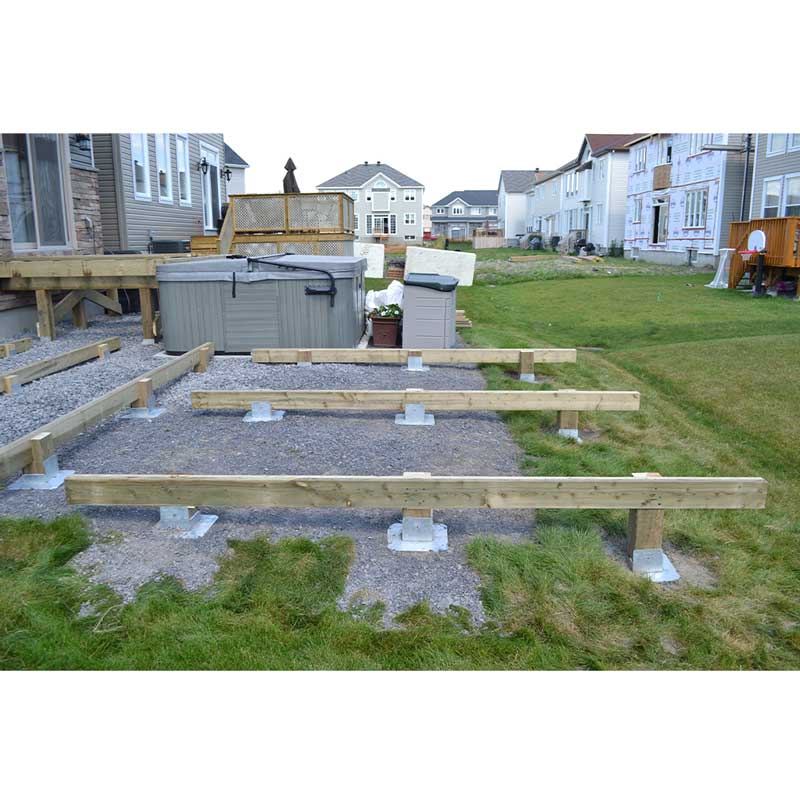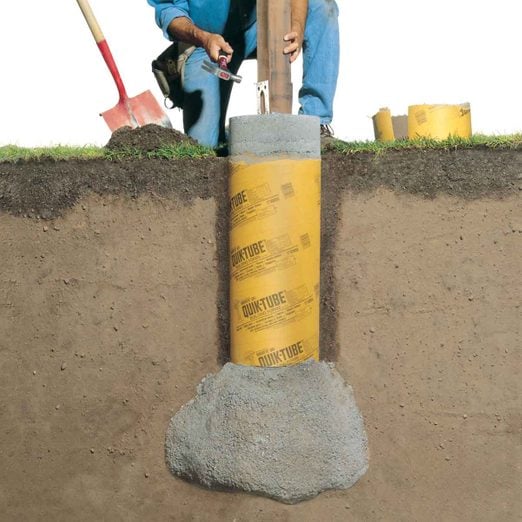Picking the Right Deck Footings for Security and Sturdiness
When it concerns building a deck, among the most critical decisions you will certainly make is selecting the right grounds for stability and resilience. The long life and security of your deck depend heavily on the kind of footings you pick, as they supply the important assistance and stability to withstand the examination of time. With a myriad of options offered, it can be overwhelming to establish which footings are best matched for your particular demands. In this discussion, we will certainly check out the numerous types of deck grounds, take into consideration the vital elements to consider when choosing, and explore the pros and disadvantages of different choices. By the end, you will certainly have a clearer understanding of the selections at hand and be much better equipped to make a notified choice for your deck project.
Sorts Of Deck Grounds
These grounds are composed of a round opening filled up with concrete, which supplies a solid foundation for the deck messages. Concrete pier footings are relatively easy to install and provide outstanding stability, making them a popular choice for many deck projects.
These footings are mounted by screwing them right into the ground, which produces a protected structure for the deck. They likewise allow for very easy modification and leveling of the deck if needed.
Alternatively, some builders select precast concrete grounds. These footings are constructed from durable concrete and can be found in different sizes and shapes to accommodate various deck designs. Precast concrete grounds are practical to mount and supply a stable base for the deck framework.
Finally, an additional option is the post-in-anchor ground system. This type of ground includes driving a steel anchor right into the ground and attaching it to the deck blog post. It uses flexibility in regards to positioning the deck blog posts and appropriates for decks with lightweight structures.
When picking the ideal type of deck ground, it is necessary to consider variables such as soil problems, deck load, and regional building ordinance (Deck Footings). Consulting with an expert service provider or structural designer can assist guarantee the appropriate ground is chosen for a secure and steady deck
Variables to Think About When Selecting Grounds
When selecting the suitable grounds for a deck, it is critical to thoroughly take into consideration numerous factors such as soil conditions, deck tons, and adherence to neighborhood building ordinance. These factors play a considerable function in making certain the stability and toughness of the deck framework.
The kind of dirt on which the deck will certainly be developed identifies the type of grounds called for. On the various other hand, decks developed on clay or expansive dirts might call for grounds that can fit the soil's propensity to increase and contract.
Another important variable is the deck tons. The weight of the deck, including the materials made use of and any type of prospective live lots such as furniture or celebrations, have to be considered when choosing grounds. The grounds should be designed to birth the weight of the deck and distribute it equally to avoid any architectural problems or failures.
Last but not least, adherence to regional building ordinance is extremely important. Building ordinance vary from area to region, and it is crucial to adhere to the specific needs set by the neighborhood authorities. Deck Footings. These codes make sure that the deck is built securely and meets the needed standards for architectural integrity and load-bearing capability
Concrete Footings: Disadvantages and pros

Concrete grounds supply numerous benefits and disadvantages when used as the foundation for a deck. On the positive side, concrete footings provide excellent stability and resilience.
One more advantage of concrete footings is their versatility. They can be poured into various forms and dimensions to suit different deck styles and setups. Concrete footings can be customized to fit the particular needs and requirements of the deck framework.
However, there are also some downsides to utilizing concrete footings. This can raise the total expense of the deck project and might need professional aid.

Helical Piers Vs. Sonotubes: Which Is Much better?
In taking into consideration the foundation options for a deck, the comparison between helical piers and sonotubes is important in establishing the premium choice. Helical piers, also referred to as screw piles, are steel shafts with helical plates connected to them. They are twisted into the ground using hydraulic machinery, offering a stable and resilient foundation for the deck. On the other hand, sonotubes are cylindrical forms made of cardboard or fiber product that are loaded with concrete. They are positioned check my blog in an opening dug right into the ground and give assistance for the deck.
The helical plates on the piers develop a strong grasp with the soil, shifting or protecting against any kind of movement of the deck. Sonotubes, on the various other hand, rely only on the concrete filling for security, which may not use the same level of strength and resistance.
In regards to installation, helical piers are fairly easier and faster to set up contrasted to sonotubes. The hydraulic machinery made use of to twist the piers right into the ground ensures a quick and reliable procedure. Sonotubes, on the other hand, need excavating holes and pouring concrete, which can be taxing and labor-intensive.
Furthermore, helical piers are an even more versatile choice. They can be made use of in various soil problems and can be readjusted or reinforced if required. Sonotubes, on the other hand, might call for added support, such as rebar, in specific soil problems or locations with high lots requirements.
Selecting the Right Footings for Your Deck's Dimensions
For ideal architectural integrity, it is vital to meticulously pick the appropriate footings that line up with the dimensions of your deck. The measurements of your deck, including its width, height, and length, play a considerable function in figuring out the kind and dimension of grounds needed.
When choosing grounds for your deck, it is necessary to take into consideration the load-bearing ability of the dirt. The weight of the deck, integrated with the weight of any type of furnishings or individuals on it, puts in a considerable force you can try here on the footings (Deck Footings). For that reason, it is important to select footings that can effectively sustain this weight without sinking or moving in time.
Larger decks with greater measurements require bigger footings to give adequate stability and assistance. The shape of the grounds, whether they are square or rounded, depends on the design and design of the deck.
Conclusion
In verdict, choosing the appropriate deck footings is crucial for making certain stability and longevity. Aspects such as the kind of footings, the deck's measurements, and the pros and cons of various options need to be thought about. Concrete grounds offer stamina and longevity, however might be more lengthy and pricey to install. Helical piers and sonotubes have their own benefits and disadvantages. Eventually, picking the suitable grounds for your deck's details requirements is necessary for a successful and lasting structure.
These footings consist of a cylindrical hole filled with concrete, which supplies a strong structure for the deck blog posts. Concrete pier grounds are relatively easy to install and offer outstanding security, making them a prominent selection for several deck tasks.
Precast concrete footings are practical to set up and supply a steady base for the deck framework.
It uses versatility in terms of placing the deck articles and is appropriate for decks with light-weight structures.
Concrete visit this site footings provide a number of advantages and downsides when utilized as the foundation for a deck.